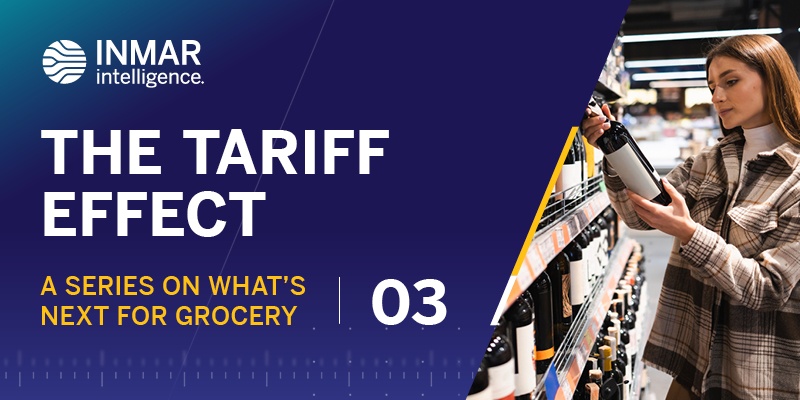
This blog is part of our ongoing series exploring how tariffs, inflation, and shifting economic forces are reshaping shopper behavior and business strategy in the grocery industry. If you missed the first post, “Navigating Tariffs, Inflation, and Uncertainty for CPGs and Retailers,” you can catch up here.
Even weeks after the latest round of U.S. tariff announcements, much remains unclear. For retailers and CPG brands, the ripple effects are still taking shape, particularly as concerns grow around grocery pricing, sourcing, and long-term consumer confidence.
Even though most of our food imports come from Canada and Mexico, which are exempt from tariffs per the U.S.-Mexico-Canada Agreement (USMCA), many agricultural inputs and food products still face increased costs due to broader supply chain impacts. As a result, shoppers will continue to feel the squeeze at the checkout line.
According to the University of Michigan’s Consumer Sentiment Index, consumer sentiment continues to decrease, marking the second-lowest reading in the survey’s history going back to 1952, and the lowest since June 2022 when inflation hit 9.1%. Shoppers are preparing for higher prices, whether it’s from inflation, tariffs, or the combination of the two. In fact, 57% of consumers say that the impact tariffs will have on food availability, price, and/or safety is their top concern for 2025, according to The Food Industry Association (FMI)
Adult Beverages — Imported & Local — Face Pressure
Adult beverage is one category that’s feeling the effects from multiple angles. While import tariffs might sound like good news for U.S.-made spirits, it’s not that simple.
Tariffs on packaging materials like aluminum cans and glass bottles are driving up costs, even for brands that source ingredients locally. Combine that with ongoing supply chain challenges, like wildfires in California wine country and ingredient shortages, and even locally-made products are becoming more expensive to produce.
The result? Consumers are likely to see higher shelf prices and/or reduced selection. With more consumers already reducing their alcohol consumption in recent years, rising prices threaten to accelerate that trend.
Turning Tariff Trouble into Opportunity
Across the board, consumers are more selective now. They’re more likely to reevaluate the brands they buy based on both dollar value and the brand’s values. When it comes to on-premise, restaurants cannot absorb increased costs given that it is such a low margin business. Not surprisingly brands will have to pass price increases onto the consumer, making going out even more expensive.
To succeed in this environment:
Target intentionally.
Brands can work with Inmar Media to activate data-driven retail media strategies that leverage our partners’ first-party retailer sales data to target price-conscious segments, like younger, health-conscious drinkers who are drawn to low-ABV or more flavorful options or even those on GLP-1s to target for non-alcoholic options.
Incentivize strategically.
In 2024, rising prices drove 53% of shoppers to start looking for coupons for the first time as shared in the 2024 Inmar Shopper Insights Survey. Economic pressure doesn’t just increase coupon use; it expands it to a broader audience, creating a key opportunity for adult beverage brands.
Offers like digital coupons, rebates, and loyalty rewards can encourage trial and build long-term value without relying on blanket discounts. Multi-item promotions or limited-time digital offers can boost trial.
Lead with value across media.
Promotions don’t work if no one sees them. Use multichannel media strategies, from display to in-store signage to influencer-led social, to communicate your value and values clearly. Consider contextual placements that match shopper intent, like mobile offers pre-trip, signage with a QR code to coupons while in-store, and loyalty rewards post-trip.
Lean into your story.
Highlight what sets you apart from competitors, whether it’s local sourcing, sustainability, quality, your mission. In a high-cost environment, shoppers are more likely to stay loyal when they feel a brand or retailer aligns with their values.
In a category like adult beverage, consumers care about ingredients, production method, authenticity, and shopper experience. Use media to clearly communicate those things that make your brand stand out and resonate with consumers.
Show up at the right moments.
Focus on high-impact consumption occasions, from weekend meals to special gatherings, where relevance could outweigh price sensitivity. Think about promotions tied to sporting events, holidays, or seasonal rituals where your product naturally fits. Even everyday micro occasions where consumers are more drawn to lower ABV cocktails, light wine spritzes, or non-alcoholic drinks. Incorporate creator content to create demand and intent-to-purchase, then win them over at the right moment with those savings.
Final Takeaway
Tariffs and inflation are reshaping how shoppers think about alcohol, not just what they buy, but why, when, and how often. In 2025, the adult beverage brands that win won’t just be offering a good product, they’ll be delivering value, purpose, and relevance in a time of heightened price sensitivity.
Whether you’re navigating rising production costs or shifting consumer preferences, now is the time to refine your approach: incentivize trial with smart offers, communicate value through meaningful media, and show up in the moments that matter, from everyday occasions to special celebrations.
The playbook is changing. And the adult beverage brands that adapt with precision and authenticity will be the ones that pour themselves a stronger future.
Stay tuned as we continue to track tariff developments and shopper sentiment and behavior shifts as a result, and, in the meantime, you can see how Jägermeister saw success aligning their media and incentives strategies here.
